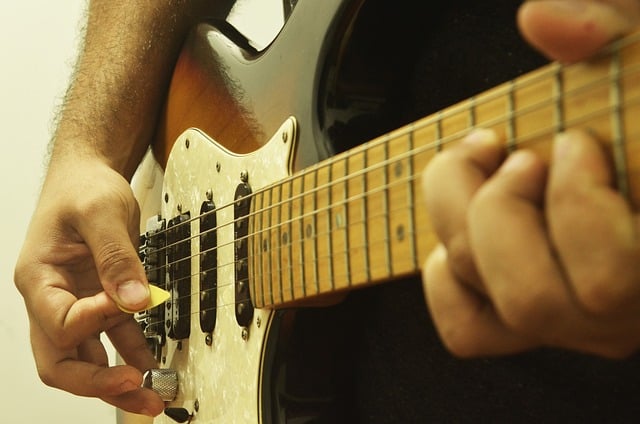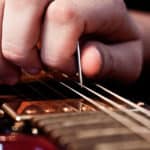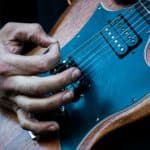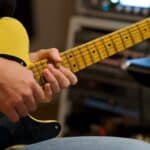Playing guitar at lightning speed is a skill that looks and sounds like magic to most of us.
It’s the ultimate exposition of talent and hours of practice put into a performance.
But which of these qualities is more important for doing it?
Do you either have it or you don’t?
Can you actually learn to play guitar faster?
And more importantly:
Are there any hacks for playing fast on guitar that can get you quick results?
Although playing guitar fast takes practice and repetition, several hacks can drastically improve your speed, like avoiding vertical motion, holding the pick correctly, and not sinking it too deeply. Also, it helps to have your guitar properly set up, and work consciously on your technique.
In this article, I will give you some hacks many pros used to learn how to shred, explain them clearly, and share some exercises for you to build a routine to work them out.
After leaving this page, you will get a quick bump in your playing speed the next time your pick up your guitar, and you will know precisely what and how to work on to keep on improving it.
Are you ready to get started?
Let’s go!
Can you really improve your guitar playing speed instantly?
Yes and no.
The sad truth is you wouldn’t get from zero to Yngwie Malmsteen after finishing this article, so set your expectations accordingly.
The good news is that if you are struggling with fast picking, probably at least a few of the following hacks will push you in the right direction.
Depending on your current state, applying just one or many of these tips will get you instantly playing faster.
However, real and consistent speed is only built with time and practice, so I’ll also give you some amazing practice routines to keep on improving.
1. Stay relaxed
You already heard this one a hundred times, but I need to stress it. Pun intended.
No real speed can be achieved if you are tense as a bowstring while trying to play a fast run.
Make a conscious effort on being relaxed.
If you feel like you tense up incrementally while you are playing set an alarm, while you practice, to repeat every 5 minutes and asses how tense you are.
If you feel any tension or strain, shake it off, stretch, focus on relaxing, and start over.
2. Hold your pick correctly
The way you hold your pick can be holding you back.
Of course, there are exceptions to this. There are pretty unorthodox pick-holders like Marty Friedman that have been killing it for decades.
However, if you are just developing your technique, it’s a great idea to start with a solid grip.
For instance, check out the way Bernth teaches his grip here:
As you can see, he places the pick perpendicular to the second phalange of his index finger and grips it parallel with the thumb, only letting the tip show.
Also, picking slightly slanted in regards to the strings will release the pick faster for the next note, in contrary to picking with your pick strictly parallel.
3. Use a proper pick
From size to thickness, it might depend on your hand.
A lot of fast players tend to use not-so-big thick picks from 1.10 mm upwards.
Some people claim that there’s a tradeoff between pick thickness or stiffness and tone, and that can be arguable, however, for speed, you will need control, and a pick that’s too flexible won’t give you any.
4. Practice at a medium speed
Teachers always tell you to start slow and build up.
That’s the best advice if you are just learning a new technique or lick from the ground up.
If that’s the case, then, by all means, play it in slow motion to get the mechanics right.
Now, if you are working on something you already know or have the hang of, go at it at a medium speed.
Play it at a bpm that feels natural to you and get it down perfectly at that pace.
Then, start working incrementally from there.
5. Proper string tension
This one is debated, some players say that higher string tension makes them more accurate and easier to attack the strings, while others claim the opposite.
In the end, it’s a matter of preference, but I encourage you to give it a try.
At least try the extremes and see which suits you better. Then go for an in-between.
Also remember that not only tension is defined by the string gauge, but also by your guitar neck’s scale.
The longer the scale, the higher the resulting tension.
6. Push yourself with a click or metronome
When practicing fast licks you should always go for consistency and timing, and there’s no better tool for that than a metronome or a drum track to play along.
Now, when you are practicing, and after finding a comfortable BPM where you can stick to the beat, you should start pushing yourself gradually.
Increase the BPM little by little so that you can adapt to the change.
Take notes and track your improvement.
Remember, however, to give it time and not push yourself too hard too soon to not get frustrated.
Aim for consistency always.
7. Not all notes should be picked
Did you know that not even Yngwie picks all the notes he plays in his fast runs?
There’s always room for a few hammer-ons or pull-offs, and learning to incorporate them seamlessly into your playing will skyrocket your speed.
If you find your legato playing needs some work, work on it for a few weeks.
Then go back to your fast runs and find spots where you could economize pick strokes in favor of legato.
You will start noticing patterns where it works, and situations where it just doesn’t.
This single tip alone can, again, make you play faster instantly if you learn how to work it in.
8. Play lines that economize movement
Although there are incredible players capable of jumping through the fretboard while maintaining a consistent, and otherworldly picking speed, you should not be expecting to do so just yet.
Focus on lines that are economical in movement. Avoid big jumps.
Play shapes that are compact and close together, and be thoughtful about how you move across them and their flow.
Think of upstrokes and downstrokes actively, and optimize your alternate picking when it’s needed.
9. Practice 3 to 4-note bursts
Think about a fast passage as a big jigsaw you are trying to solve.
Break it down into parts and practice them one by one.
3 to 4 or 5-note blocks are great ways of approaching it.
Of course, try to not hurt the actual flow of the line when chopping it down.
Look for rhythmic patterns that can be looped over and bore yourself to death with them, one at a time.
Then work on gluing them together once you have them down.
Learn the first 3 blocks and then learn to play them back to back, then go for the next 3.
And so on.
10. Don’t sink your pick too deeply
Floyd Rose, the same guy who invented the legendary floating bridge, has more recently created a contraption that binds to the body of a guitar, just under where you are intended to pick, that prevents you from sinking in your pick too deeply between the strings.
The results, from players that have tried it, are only positive.
Letting your pick go down too deeply between the strings only slows you down when trying to play fast.
The pick gets “stuck” and takes longer for it to reset and be available for playing the next note.
It also requires extra energy to perform the extra action that takes to get it out fast enough, and playing quickly is about economizing movement.
This might mean you will have to rework your whole picking technique, but it’s something to have in mind, and perhaps one of the main things holding you back.
11. Fret as lightly as possible
For some players, the speed constraint comes from the left hand, and a big tension generator and speed-killer in many cases is a death grip on the frets.
You should always try to fret as lightly as possible.
Just as hard as it’s needed to make the note ring properly, but no more than that.
It’s natural to tense up when trying a fast run, but be aware of that and work it out slowly first to learn how to relax.
12. Lower the action of your guitar
High-string action makes you press the frets harder for the strings to sit on them.
This not only tenses you up but also the travel time of the strings from their resting position to their fretted stance starts to add up.
While a higher action might feel great for you if you intend to improve your speed, try to lower it a little.
Most fast players prefer flatter fretboard radii and lower-string actions.
13. Avoid vertical motion
“Vertical motion” refers to the movement a lot of players make when going from one string to another in regards to the plane in which they are.
An exaggerated way of imagining it to make a clear picture in your head is as if the strings were extremely hot and you burnt your hand every time you picked them.
This would cause you to take your hand out of the guitar “vertically” immediately.
Now, you probably don’t do it consciously, but there might be a bit of it when you play.
Try to identify this motion and work against it.
Your pick should flow as parallel to the plane described by the strings as possible
14. Keep fretting fingers close to the fretboard
This is an issue very common with novice players, but even the most advanced of us sometimes forget about it and still do it.
Don’t take your hand away from the frets when you are not fretting them.
Keep your fingers ready and almost touching the strings to make the most efficient movement possible when it’s needed to fret a note.
15. Don’t anchor your picking hand
Anchoring in guitar means having some of your fingers or any part of your hand touching the instrument while you pick.
This is used as a reference point and is great for playing broken chords for instance.
However, for fast playing, anchors can hold you back a little and limit your speed.
Are there great fast players that anchor and still can melt your face?
Yes, for sure.
But give it a try, anyway.
This is another one of those where it depends on your technique, but for me personally, picking with a “floating” hand really improved my speed for fast licks.
Great resources to dive deeper
Here are some great resources on which I based a lot of these hacks, and where you can look further into them with practical examples:
7 workouts to improve your guitar-playing speed
Once you identified your flaws, now it’s time to start working out on a long-term improvement of your technique.
Here I gathered 7 great workouts to improve on specific aspects of your playing:
Fast picking:
Legato:
Sweep Picking:
How to get unstuck when you plateau?
It’s only natural that when grinding on improving your technique you will find a plateau in your progress.
I have written an article about how to deal with it that you can read here:
However, to sum it up, the best you can do is take some time off from your regular practice and just play music and have a good time.
Learning guitar shouldn’t be a chore, and if whatever you are doing starts becoming frustrating, it’s time to mix things up and deal again.
Go and play with other people, learn new songs, or just give yourself a week off from your current practice routine and start working on other things.
Tools that will help you improve your guitar speed
Unfortunately, there’s no magic device that will make you play faster in a day.
However, the most important tool to work on your speed and consistency is a metronome.
Be it analog, digital, an app, or a website, as long as you can adjust its tempo easily it will work.
Drum or full-band backing tracks are also great, but you don’t get the easy tempo shift with them.
However, they are great for learning to lock in with a band.
Can anybody play guitar fast?
Absolutely!
With the proper technique and enough practice, just anyone can play guitar fast.
Some people will have it easier than others, talent is a weird thing.
But hard work will get you there, I promise.
In the long run, it’s a matter of putting down the hours and being patient.
The most important thing, however, is to not get frustrated or discouraged during the journey.
Small steps will get you toward your goals. Always.
Do you need to learn how to play fast to be a good guitarist?
Not at all.
There are amazing guitar players that just don’t play fast.
Perhaps it’s not that they can’t, but they prefer not to do so.
Music is not a competition, and there are no medals for fretboard sprinters, believe me.
In certain genres speed might be expected, but there’s a limit to what fast playing can do for you as a musician.
If you play boring things nobody will want to listen to your music, as fast as you are.
Is speed really that important when playing the guitar?
Having the ability to play fast will give you some slack when playing slower-than-your-limit tunes.
However, apart from that, there are no inherent benefits from playing at lightning speeds, other than polishing your overall technique.
As I mentioned above, there are guitar legends that just don’t do speed.
And, as long as you can captivate the audience with something else than fast licks, it will be fine.
Remember also to play some music
Being a musical player, in my opinion, is way more important than just being a fast or extremely technical player.
I, as a listener, don’t really care about your sweep picking or incredible three-digit BPM alternate picking if your music puts me to sleep.
I’d rather listen to someone that can barely strum a few chords but somehow makes me feel something new with his music that catches me.
Think of Kurt Cobain.
I’m not saying he couldn’t play the guitar at all, but a few chords were enough for him to write and perform timeless tunes.
Take it easy, you don’t need to be the fastest
All of this being said, I do think there’s merit in learning to play guitar fast, however, I don’t believe it should be the whole thing.
There will always be someone faster or more good-looking.
Don’t waste your life comparing to others.
Do your own thing, and do it well.

Hello there, my name is Ramiro and I’ve been playing guitar for almost 20 years. I’m obsessed with everything gear-related and I thought it might be worth sharing it. From guitars, pedals, amps, and synths to studio gear and production tips, I hope you find what I post here useful, and I’ll try my best to keep it entertaining also.





